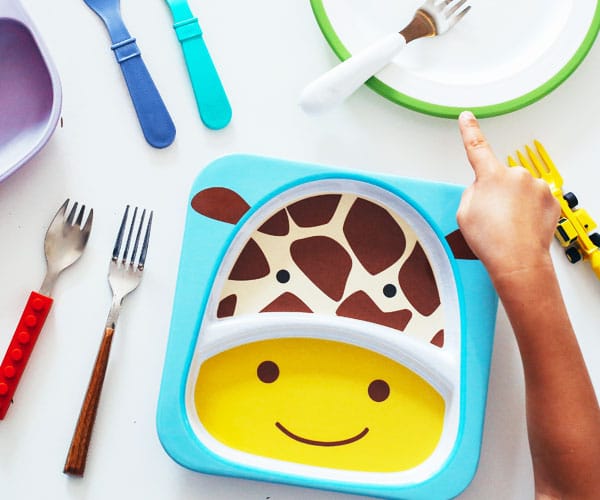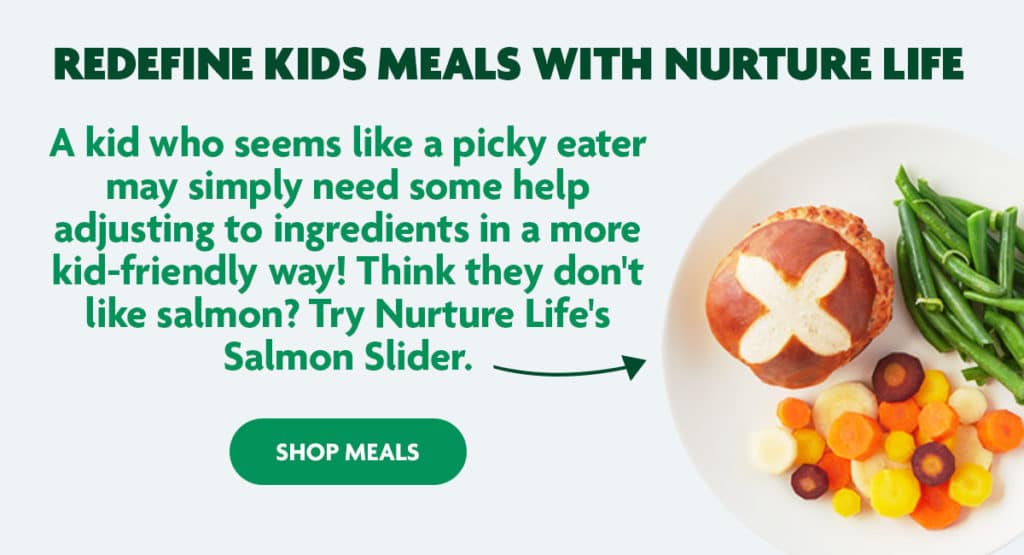How to Raise Kids Who Don’t Need “Kids Meals”
The next time you visit your local grocery store, take a minute to look around at the kids food options. You don’t have to look very long—a quick glance will show you what’s on offer: the same five or so ingredients, cooked into the same three dishes.
If this sounds familiar to you, it’s all too familiar to us, too! An entire industry is devoted to selling parents on the idea of dedicated food for kids, creating a strong but unspoken rule that kids need “kids meals.” But do they really?
Kids Food vs. Healthy Meals for Kids
Let’s start off by clarifying: we at Nurture Life love kids meals! Our entire mission is built around creating wholesome meals for babies and kids of all ages. What we don’t love is what so often passes for kids meals today.
In a quest to make increasingly kid-friendly dinners, many food manufacturers have shifted toward easy wins like sugar, salt and fat—which has in turn set pretty low expectations for what kids meals ought to be. We’re often told that kids should eat cheesy pepperoni pizza, not veggie pizza; french fries, not sweet potatoes; fish sticks, not salmon fillets.
If these are the accepted idea of “kids meals,” we believe it’s time to change the definition! Even small changes can help equip our children for a more positive relationship with food, which is important in a time when nearly 1 in 5 kids in the United States has obesity—a rate that’s more than tripled since the 1970s and is only poised to grow from here.
Picky Eater or Lack of Options?
Beyond the potential health concerns, the slim variety of conventional kids meals also makes it easy for children to fall into a “repeat eater” pattern. Without much opportunity to push their boundaries, it’s not hard to see why some children fall into picky eating habits and stubborn mealtime preferences.
It’s not that kids are born picky eaters; many of them just get used to the same flavor profiles and ingredients that are recycled into so many kids meals today!
“If kids come to view certain food as ‘adult food’ and other foods as ‘kids food,’ then they’re primed to reject some of the most nutritious (and delicious!) foods out there. Removing this label can help your child enjoy healthy, well-rounded meals and take away some of the battle,” explains Nurture Life’s pediatric registered dietitian, Lara Field.
5 Ways to Raise a Child with a Broader, Healthier Palate
There are all kinds of eaters out there, and some kids will always be pickier than others. Still, there are ways to nurture a better eater from the start and even to “rehab” a picky eater toddler or child who’s fallen into some bad habits.
Here’s what the experts recommend.
1. Communicate With Your Kids
Establishing open communication with your children is one of the best ways to develop a wider palate from an early age. (Or older age—it’s never too late to start!)
This communication can revolve around individual meals as well as food for kids in general:
- Explain how the foods we eat can help us feel good and have energy for our favorite activities.
- Connect a healthy, well-balanced meal with something your child loves, like swimming or playing tag.
- Tell your kids what you’ll be eating (including the veggies!) so they’ll know exactly what to expect.
According to Nurture Life’s registered dietitian Rachael Janas, you can be honest about what you’re eating and why without making a big deal out of it, either. She explains, “Instead of playing up the fact that you’re eating ‘adult food,’ just be honest and nonchalant about. Set the expectation that we’re eating this meal so that we can do the things we love.”
2. Don’t Always Hide the Veggies
Along with family discussions, open communication can also happen on the plate! Instead of always hiding the veggies, try to be open about what your kids are eating. Hiding the vegetables may help now, but it won’t encourage greater acceptance over the long run.
If your kid has already developed some picky eating habits, they might not react well to this change in presentation. Our chef’s advice here is to just keep trying!
Nurture Life chef Imaide Steverango has been a kids chef for a long time, specializing in meals for children from 6 months all the way into their teens. Her approach to kids meals has always been to serve creative recipes that many might consider “too adventurous.” But her experience has shown her one thing: after enough exposure, kids will try new foods.
“Sometimes we don’t give kids enough credit. It may take some time for kids who aren’t used to certain flavors or textures, but they can learn to accept new foods, even veggies that aren’t hidden at all,” she says.
There’s nothing wrong with hiding veggies from time to time, and some Nurture Life meals do it too. Our Mac & Cheese with Hidden Butternut Squash, for instance, hides pureed butternut squash in the cheesy sauce. But most of our meals are about showcasing veggies and enhancing them with different sauces, seasonings and flavor combinations.
3. Make “Grown-Up” Food Kid-Friendly

At least some of the fun of conventional kids meals comes not from the foods themselves but rather the presentation. (Happy Meal toys, anyone?) If your little one is hesitant to try new foods, you can always jazz up the presentation without changing the core ingredients!
Make lunch or dinner more kid-friendly by serving it on a themed plate with matching tableware or offering your kid’s choice of picky eater tools. Kids dinner ideas for picky eaters can include dusting broccoli with Parmesan “snow” or making a game out of dipping veggies in Greek yogurt dressing.
4. Get Your Kid Involved

To encourage your child to embrace new foods, it’s often helpful to get your kid involved with meals long before mealtime. Here are a few ideas:
- Give them choices at mealtime. Let them choose one dish for the family to share, or have them select their own meals when you order their next kids meal delivery.
- Set up a kid-friendly kitchen station and/or dedicated pantry shelf that’s full of healthy snacks and kid-safe kitchen utensils.
- Get them to help with meal prep. Assign fun tasks based on age, such as fetching veggies, washing them, or stirring the pot.
The more involved your children are, the more invested and familiar they’ll feel when it’s time to sit down and eat.
5. Give Your Kid Time
Whether you’re introducing a new food to a baby or trying to get an older kid to accept more variety, the same fact holds true: it just takes time! Kids need to be exposed enough to actually accept new foods—which often means several flat-out refusals followed by gradual acceptance.
The first time Nurture Life co-founder Jennifer fed her son our Chicken Biryani, he took one bite and immediately started crying. She later reintroduced the meal and let him explore it at his own pace…and now he loves it.
Change can be hard for little ones that are already changing so much, so sometimes you have to give them time to become familiar and adjust.
Raising the Bar for “Kids Meals”
At Nurture Life, we understand that there are all kinds of eaters out there and room for all kinds of foods at the table. There’s nothing wrong with the occasional treat like pizza or burgers, but we also believe that there’s a far better way to define “kids meals” in general—one that gives our children more room for exploration and more confidence in trying new foods.
Some of our baby and kids meals lean toward conventional kids meals, while others look more like dishes you’d eat yourself (and you can eat them yourself!). Whichever is right for your little ones, we always focus on balanced nutrition and introducing “grown-up” foods in a kid-centric way.
If you have questions about how to build a more diverse palate or what goes into our meals for picky eaters), please don’t hesitate to contact our dietitians directly at nutrition@nurturelife.com.







